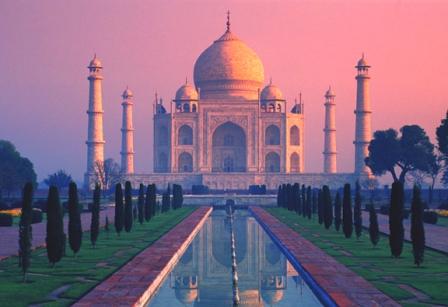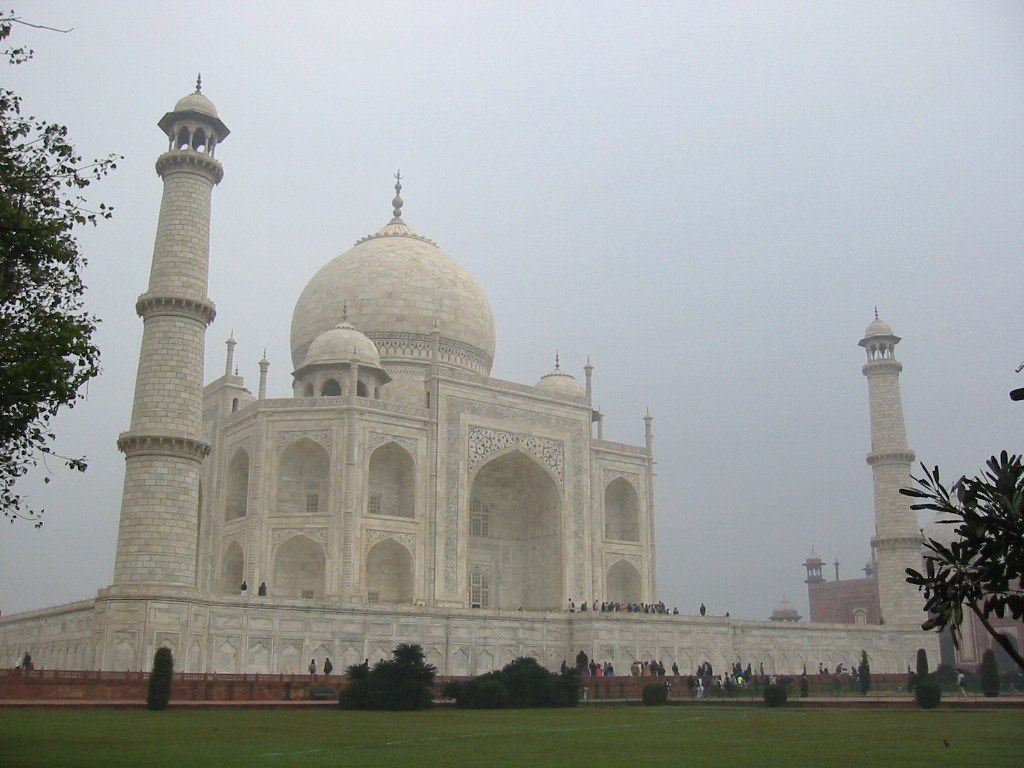Find information about the top tourist destinations of the world at a single place
Tuesday, January 19, 2010
Taj Mahal Building in India
The Taj Mahal base structure is a large, multi-chambered structure. The base is essentially a cube with chamfered edges and is roughly 55 meters on each side (see floor plan, right). On the long sides, a massive pishtaq, or vaulted archway, frames the iwan with a similar arch-shaped balcony. On either side of the main arch, additional pishtaqs are stacked above and below. This motif of stacked pishtaqs is replicated on chamfered corner areas as well. The design is completely symmetrical on all sides of the building. Four minarets, one at each corner of the plinth, facing the chamfered corners, frame the tomb. The main chamber houses the false sarcophagi of Mumtaz Mahal and Shah Jahan; their actual graves are at a lower level.
The marble dome that surmounts the tomb is its most spectacular feature. Its height is about the same size as the base of the building, about 35 meters, and is accentuated as it sits on a cylindrical "drum" of about 7 metres high. Because of its shape, the dome is often called an onion dome (also called an amrud or guava dome). The top is decorated with a lotus design, which serves to accentuate its height as well. The shape of the dome is emphasised by four smaller domed chattris (kiosks) placed at its corners. The chattri domes replicate the onion shape of the main dome. Their columned bases open through the roof of the tomb and provide light to the interior. Tall decorative spires (guldastas) extend from edges of base walls, and provide visual emphasis to the height of the dome. The lotus motif is repeated on both the chattris and guldastas. The dome and chattris are topped by a gilded finial, which mixes traditional Persian and Hindu decorative elements. The main dome is crowned by a gilded spire or finial. The finial, made of gold until the early 1800s, is now made of bronze. The finial provides a clear example of integration of traditional Persian and Hindu decorative elements. The finial is topped by a moon, a typical Islamic motif, whose horns point heavenward. Because of its placement on the main spire, the horns of moon and finial point combine to create a trident shape, reminiscent of traditional Hindu symbols of Shiva.
The exterior decorations of the Taj Mahal are among the finest to be found in Mughal architecture. As the surface area changes, a large pishtaq has more area than a smaller one, and the decorations are refined proportionally. The decorative elements were created by applying paint or stucco, or by stone inlays or carvings. In line with the Islamic prohibition against the use of anthropomorphic forms, the decorative elements can be grouped into either calligraphy, abstract forms or vegetative motifs.
The interior chamber of the Taj Mahal steps far beyond traditional decorative elements. Here the inlay work is not pietra dura, but lapidary of precious and semiprecious gemstones. The inner chamber is an octagon with the design allowing for entry from each face, though only the south garden-facing door is used. The interior walls are about 25 metres high and topped by a "false" interior dome decorated with a sun motif. Eight pishtaq arches define the space at ground level. As with the exterior, each lower pishtaq is crowned by a second pishtaq about midway up the wall. The four central upper arches form balconies or viewing areas and each balcony's exterior window has an intricate screen or jali cut from marble. In addition to the light from the balcony screens, light enters through roof openings covered by chattris at the corners. Each chamber wall has been highly decorated with dado bas relief, intricate lapidary inlay and refined calligraphy panels, reflecting in miniature detail the design elements seen throughout the exterior of the complex. The octagonal marble screen or jali which borders the cenotaphs is made from eight marble panels. Each panel has been carved through with intricate pierce work. The remaining surfaces have been inlaid with semiprecious stones in extremely delicate detail, forming twining vines, fruits and flowers.
Subscribe to:
Post Comments (Atom)




No comments:
Post a Comment